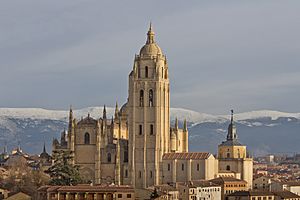Segovia Cathedral facts for kids
Quick facts for kids Segovia Cathedral |
|
|---|---|
| Cathedral of Our Lady of the Assumption and of Saint Fructus | |
| Catedral de Nuestra Señora de la Asunción y de San Frutos | |

West façade and bell tower as seen from the Alcázar.
|
|
| 40°57′00″N 4°07′31″W / 40.95°N 4.12528°W | |
| Location | Segovia |
| Country | Spain |
| Denomination | Catholic |
| History | |
| Status | Cathedral |
| Dedication | Assumption of the Virgin Mary and Saint Fructus |
| Dedicated | 16 July 1768 |
| Architecture | |
| Architect(s) | Juan Gil de Hontañón (first) |
| Style | Late Gothic |
| Groundbreaking | 8 June 1525 |
| Specifications | |
| Tower height | 88 m (288 ft 9 in) |
| Administration | |
| Metropolis | Valladolid |
| Diocese | Segovia (since 6th Century) |
The Cathedral of Our Lady of the Assumption and of Saint Fructus is a Roman Catholic cathedral located in the Spanish city of Segovia. The church is dedicated to the Assumption of the Virgin Mary and to Saint Fructus and is the seat of the Diocese of Segovia. It was built in the Flamboyant style, and was dedicated in 1768, constituting one of the latest Gothic cathedrals in Europe.
History
The massive cathedral was built between 1525 and 1577 in a late Gothic style, outdated elsewhere in Europe. The previous cathedral of Segovia had stood adjacent to the Alcazar, and had been used by the royal armies in defending the latter against siege. The rebellious Comuneros were intent on taking the cathedral to protect its holy relics, and to use its position against the walls of the Alcazar in order to defeat its defenders. In a famous exchange, prominent city officials urged the comuneros to halt their attacks on the church, saying they should consider the injustice of razing so sumptuous a temple while making war against those who, serving their king, defended his Alcazar. But their plea fell on deaf ears, and the comuneros replied: la Iglesia era de la Ciudad (the Church belonged to the City). After a bitter siege lasting months, the cathedral lay in ruins.
Due to fears of a repeat assault, the cathedral was relocated to the present site and built using a design by the Trasmeran mason named Juan Gil de Hontañón, and the work was continued by his son Rodrigo Gil de Hontañón.
Architecture
The building's structure features three tall vaults and an ambulatory, with fine tracery windows and numerous stained glass windows. The interior is characterized by unity of style (late Gothic), except for the dome, built around 1630 by Pedro de Brizuela. The Gothic vaults are 33 meters high by 50 meters wide and 105 long. The bell tower reaches almost 90 meters. The current stone spire crowning the tower, dating from 1614, was erected after a major fire caused by a thunderstorm. The original spire, entirely Gothic, was built of American mahogany, had a pyramidal structure, and was the tallest tower in Spain.
The retablo mayor, or main reredos, of the cathedral was carved by Francisco Sabatini, and is dedicated to the Virgin of the Peace. It is adorned with the Segovian Saints Frutos, Geroteo, Valentín and Engracia. The choir has gothic seating.
Chapels
Among the most prominent chapels are that of the Santísimo Sacramento, with a Reredo by José de Churriguera, the Chapel of San Andrés, with a Triptych of the Deposition by Ambrosius Benson, the Chapel of Piety with the Entombment by Juan de Juni; and the chapel of the Deposition with the recumbent Christ by Gregorio Fernández.
- Capilla de San Andrés Apóstol
- Capilla de San Cosme y San Damián
- Capilla de San Gregorio
- Capilla de la Concepción
- Capilla del Cristo Yacente (Reclining Christ)
- Capilla de Santa Bárbara
- Capilla de Santiago Apóstol
- Capilla del Cristo del Consuelo
Burials
- Crescentius of Rome
- Saint Fructus (d. 715), and his siblings Saint Valentine (Valentín) and Saint Engratia (Engracia).
Museum
The cathedral museum has works by Pedro Berruguete, Sánchez Coello and Van Orley, and the cathedral archives treasure the first printed book made in Spain: the Synod of Aguilafuente (1472).
Gallery
-
Vitreaux of Virgin Mary.
See also
 In Spanish: Catedral de Segovia para niños
In Spanish: Catedral de Segovia para niños
- Roman Catholic Diocese of Segovia
- List of cathedrals in Spain









